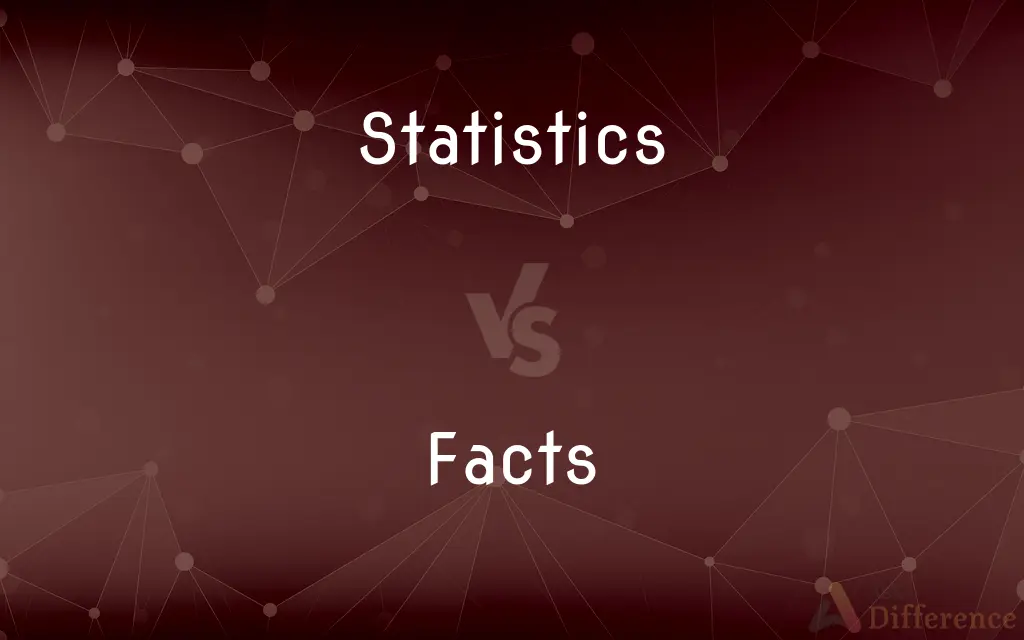Statistics vs. Facts — What's the Difference?
Edited by Tayyaba Rehman — By Fiza Rafique — Updated on May 17, 2024
Statistics are numerical data derived from analysis and research, while facts are statements that are objectively true and verifiable.

Difference Between Statistics and Facts
Table of Contents
ADVERTISEMENT
Key Differences
Statistics are quantitative data collected and analyzed to provide insights into various phenomena. They are often presented as percentages, averages, or other numerical representations derived from research or surveys. Facts, on the other hand, are statements that describe reality and are indisputable, being based on evidence that can be verified independently.
Statistics provide a way to summarize and interpret large sets of data, offering a snapshot of trends or patterns. For example, statistics can show the average income in a country or the percentage of people who prefer a particular product. Facts, however, are concrete pieces of information, such as "the Earth orbits the Sun" or "water boils at 100°C at sea level."
While statistics can help identify correlations and make predictions, they can also be misinterpreted or manipulated, depending on how data is presented or the sample used. Facts remain constant regardless of interpretation or context, providing a foundation of truth upon which further understanding can be built.
Statistics often require context and careful analysis to be meaningful. For instance, a statistic showing a 10% unemployment rate needs additional context about the labor market and economic conditions. Facts are standalone truths that do not depend on additional information to be understood and accepted.
Statistics can be dynamic and change over time as new data is collected and analyzed. For example, the statistical average income of a population can fluctuate based on economic conditions. Facts, however, are static and remain unchanged; for example, historical facts like "Neil Armstrong was the first person to walk on the moon" do not change over time.
ADVERTISEMENT
Statistics can be used to support arguments or hypotheses in various fields such as science, economics, and social studies. They are crucial in forming data-driven conclusions. Facts serve as the basis for knowledge and understanding, providing the irrefutable evidence needed to build and verify further information.
Comparison Chart
Nature
Quantitative data
Verifiable truths
Interpretation
Requires context and analysis
Standalone and self-explanatory
Changeability
Can change over time with new data
Static and unchanging
Usage
Used to summarize and interpret data
Basis for knowledge and understanding
Example
"10% of people are unemployed"
"The Earth orbits the Sun"
Compare with Definitions
Statistics
Data presented as numerical summaries.
The statistics on the report highlight the company's growth.
Facts
Information based on reality and evidence.
The fact that gravity pulls objects towards the Earth is undeniable.
Statistics
Numerical data representing a set of information.
Statistics show that 70% of people own a smartphone.
Facts
Truths that do not change over time.
The fact that the Earth revolves around the Sun remains constant.
Statistics
A branch of mathematics dealing with data collection and interpretation.
In statistics, we calculate the mean to find the average.
Facts
Statements that can be proven true.
It is a fact that water freezes at 0°C.
Statistics
Quantitative analysis of data to identify trends.
Crime statistics indicate a decrease in theft this year.
Facts
Concrete details that are universally accepted.
The fact that humans need oxygen to survive is well known.
Statistics
Probabilistic data used for predictions.
Election statistics predict a close race between candidates.
Facts
Objective truths that are verifiable.
The fact that Paris is the capital of France can be confirmed.
Statistics
Statistics is the discipline that concerns the collection, organization, analysis, interpretation, and presentation of data. In applying statistics to a scientific, industrial, or social problem, it is conventional to begin with a statistical population or a statistical model to be studied.
Facts
Knowledge or information based on real occurrences
An account based on fact.
A blur of fact and fancy.
Statistics
The practice or science of collecting and analysing numerical data in large quantities, especially for the purpose of inferring proportions in a whole from those in a representative sample.
Facts
Something demonstrated to exist or known to have existed
Genetic engineering is now a fact. That Chaucer was a real person is an undisputed fact.
Statistics
(used with a sing. verb) The mathematics of the collection, organization, and interpretation of numerical data, especially the analysis of population characteristics by inference from sampling.
Facts
A real occurrence; an event
Had to prove the facts of the case.
Statistics
(used with a pl. verb) Numerical data.
Facts
Something believed to be true or real
A document laced with mistaken facts.
Statistics
A discipline, principally within applied mathematics, concerned with the systematic study of the collection, presentation, analysis, and interpretation of data.
Statistics is the only mathematical field required for many social sciences.
Facts
A thing that has been done, especially a crime
An accessory before the fact.
Statistics
The science which has to do with the collection, classification, and analysis of facts of a numerical nature regarding any topic.
Facts
(Law) A conclusion drawn by a judge or jury from the evidence in a case
A finding of fact.
Statistics
Classified facts of a numerical nature regarding any topic.
Facts
Plural of fact
Statistics
The branch of mathematics which studies methods for the calculation of probabilities.
Facts
(Internet slang) Used to express agreement.
Statistics
A branch of applied mathematics concerned with the collection and interpretation of quantitative data and the use of probability theory to estimate population parameters
Common Curiosities
What is the primary difference between statistics and facts?
Statistics are numerical data from analysis, while facts are verifiable truths.
Can statistics be considered facts?
Statistics can illustrate facts but are often subject to interpretation and context.
Are all facts supported by statistics?
Not necessarily; facts are supported by verifiable evidence, not always numerical data.
Why do statistics change over time?
Statistics change as new data is collected and analyzed.
Can statistics be misleading?
Yes, if presented without context or with biased interpretation.
Why is context important for statistics?
Context ensures accurate interpretation and relevance of the data.
How are statistics used in research?
Statistics summarize and interpret data to identify trends and correlations.
Can opinions be based on statistics?
Yes, opinions often use statistics for support, though they remain subjective.
Do facts ever change?
No, facts remain constant and unchanging.
What role do facts play in knowledge?
Facts provide a foundation of truth for building further understanding.
How can one verify a fact?
A fact can be verified through observation, evidence, and reliable sources.
What is an example of a fact?
The fact that the sky is blue can be observed and verified.
Do statistics require mathematical skills?
Yes, understanding and analyzing statistics often require mathematical knowledge.
Are historical records considered facts or statistics?
Historical records are considered facts if they are verifiable.
How are facts used in education?
Facts are taught to establish a base of knowledge and understanding.
Share Your Discovery

Previous Comparison
Bring vs. Introduce
Next Comparison
Jersey vs. PinnyAuthor Spotlight
Written by
Fiza RafiqueFiza Rafique is a skilled content writer at AskDifference.com, where she meticulously refines and enhances written pieces. Drawing from her vast editorial expertise, Fiza ensures clarity, accuracy, and precision in every article. Passionate about language, she continually seeks to elevate the quality of content for readers worldwide.
Edited by
Tayyaba RehmanTayyaba Rehman is a distinguished writer, currently serving as a primary contributor to askdifference.com. As a researcher in semantics and etymology, Tayyaba's passion for the complexity of languages and their distinctions has found a perfect home on the platform. Tayyaba delves into the intricacies of language, distinguishing between commonly confused words and phrases, thereby providing clarity for readers worldwide.
















































